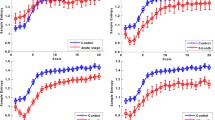Abstract
Unstable conduction system bifurcations following ischemia and infarction are associated with variations in the electrocardiographic activity spanning the heart beat. In this paper, we investigate a spectral energy measure of morphologic differences (SE-MD) that quantifies aspects of these changes. Our measure uses a dynamic time-warping approach to compute the time-aligned morphology differences between pairs of successive sinus beats in an electrocardiographic signal. While comparing beats, the entire heart beat signal is analyzed in order to capture changes affecting both depolarization and repolarization. We show that variations in electrocardiographic activity associated with death can be distinguished by their spectral characteristics. We developed the SE-MD metric on holter data from 764 patients from the TIMI DISPERSE2 dataset and tested it on 600 patients from the TIMI MERLIN dataset. In the test population, high SE-MD was strongly associated with death over a 90 day period following non-ST-elevation acute coronary syndrome (HR 10.45, p < 0.001) and showed significant discriminative ability (c-statistic 0.85). In comparison with heart rate variability and deceleration capacity, SE-MD was also the most significant predictor of death in the study population. Furthermore, SE-MD had low correlation with these other measures, suggesting that complementary use of the risk variables may allow for more complete assessment of cardiac health.




Similar content being viewed by others
References
Acar B, Yi G, Hnatkova K, Malik M. Spatial, temporal and wavefront direction characteristics of 12-lead T-wave morphology. Med Biol Eng Comput. 1999;37:574–84.
Bauer A, Kantelhardt JW, Barthel P, Schneider R, Ing D, Makikallio T, et al. Deceleration capacity of heart rate as a predictor of mortality after myocardial infarction: cohort study. Lancet. 2006;367:1674–81.
Ben-Haim SA, Becker B, Edoute Y, Kochanovski M, Azaria O, Kaplinksy E, et al. Beat-to-beat electrocardiographic morphology variation in healed myocardial infarction. Am J Cardiol. 1991;68:725–8.
Cannon CP, Husted S, Harrington RA, Scirica BM, Emanuelsson H, Peters G, et al. Safety, tolerability, and initial efficacy of AZD6140, the first reversible oral adenosine diphosphate receptor antagonist, compared with clopidogrel, in patients with non-ST-segment elevation acute coronary syndrome. J Am Coll Cardiol. 2007;50:1844–51.
Clifford G, Tarassenko L. Quantifying errors in spectral estimates of HRV due to beat replacement and resampling. IEEE Trans Biomed Eng. 2005;52:630–8.
Cox DR, Oakes D. Analysis of survival data. London: Chapman and Hall; 1984.
DeChazal P, O’Dwyer M, Reilly R. Automatic classification of heartbeats using ECG morphology and heartbeat interval features. IEEE Trans Biomed Eng. 2004;51:1196–206.
Donoho D. Denoising by soft-thresholding. IEEE Trans Inf Theory. 2005;41:613–27.
El-Sherif N, Hope RR, Scherlag BJ, Lazara R. Reentrant ventricular arrhythmias in the late myocardial infarction period. Circulation. 1977;55:702–19.
Hamilton PS. Open source ECG analysis software documentation. Somerville: EP Limited; 2002.
Hamilton PS, Tompkins WJ. Quantitative investigation of QRS detection rules using the MIT/BIH arrhythmia database. IEEE Trans Biomed Eng. 1986;33:1157–65.
Josephson ME, Wit AL. Fractionated electrical activity and continuous electrical activity: fact or artifact? Circulation. 1984;70:529–32.
Li Q, Mark RG, Clifford GD. Robust heart rate estimate fusion using signal quality indices and a Kalman filter. Physiol Meas. 2008;29:15–32.
Lomb NR. Least-squares frequency analysis of unequally spaced data. Astrophys Space Sci 1976;39:446–62.
Malik M. Heart rate variability: standards of measurement, physiological interpretation, and clinical use. Circulation. 1996;93:1043–65.
Morrow DA, Scirica BM, Prokopczuk E, Murphy SA, Budaj A, Varshavsky S, et al. Effects of ranolazine on recurrent cardiovascular events in patients with non-ST-elevation acute coronary syndromes: the MERLIN-TIMI 36 randomized trial. JAMA. 2007;297:1775–83.
Myers C, Rabiner L, Rosenberg A. Performance tradeoffs in dynamic time-warping algorithms for isolated word recognition. IEEE Trans Acoust. 1980;6:623–35.
Ohman E, Granger C, Harrington R, Lee K. Risk stratification and therapeutic decision-making in acute coronary syndromes. JAMA. 2000;284:876–8.
Rabiner L. Considerations in dynamic time-warping algorithms for discrete word recognition. IEEE Trans Signal Process. 1978;26:575–82.
Rosenbaum DS, Jackson LE, Smith JM, Garan H, Ruskin JN, Cohen RJ. Electrical alternans and vulnerability to ventricular arrhythmias. N Engl J Med. 1994;330:235–41.
Syed Z, Guttag J, Stultz C. Clustering and symbolic analysis of cardiovascular signals: discovery and visualization of medically relevant patterns in long-term data with limited prior knowledge. EURASIP J Adv Signal Process. 2007;2007:90. doi:10.1155/2007/67938.
Zabel M, Acar B, Klingenheben T, Franz MR, Hohnloser SH, Malik M. Analysis of 12-lead T-wave morphology for risk stratification after myocardial infarction. Circulation. 2000;102:1252–7.
Zong W, Moody GB, Jiang D. A robust open-source algorithm to detect onset and duration of QRS complexes. Comput Cardiol. 2003;30:737–40.
Acknowledgments
We would like to thank Gari Clifford for providing tools from Physionet for preprocessing ECG signals and for his technical input on heart rate variability metrics, and Dorothy Curtis for helping with the computational needs for this project. This work was supported, in part, by the Center for Integration of Medicine and Innovative Technology (CIMIT), the Harvard-MIT Division of Health Sciences and Technology (HST), and the Industrial Technology Research Institute (ITRI).
Author information
Authors and Affiliations
Corresponding author
Rights and permissions
About this article
Cite this article
Syed, Z., Sung, P., Scirica, B.M. et al. Spectral Energy of ECG Morphologic Differences to Predict Death. Cardiovasc Eng 9, 18–26 (2009). https://doi.org/10.1007/s10558-009-9066-3
Published:
Issue Date:
DOI: https://doi.org/10.1007/s10558-009-9066-3




